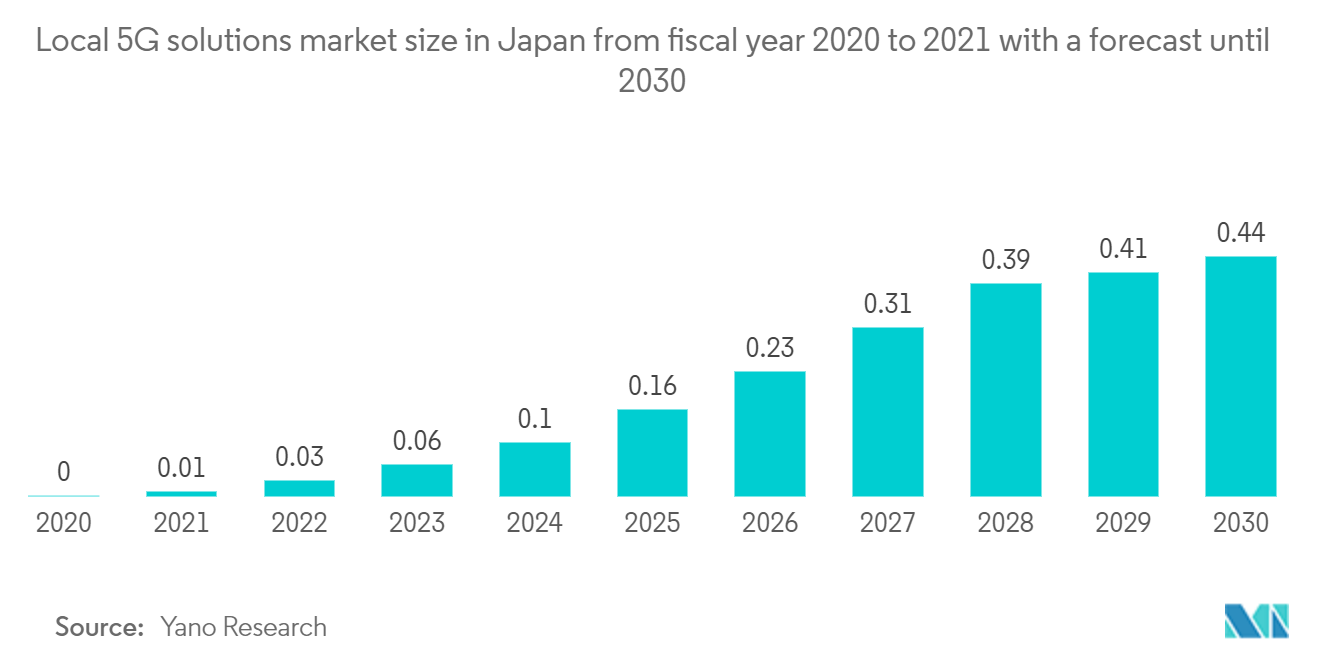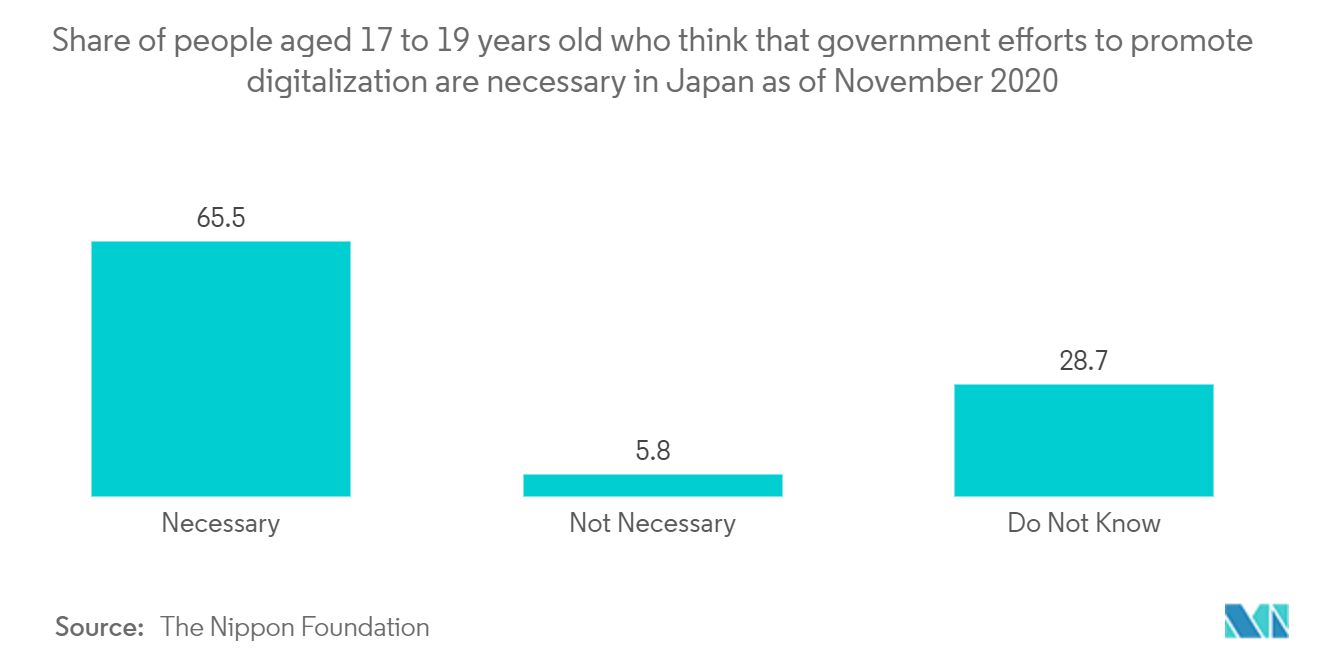Market Trends of Japan Telecom Industry
This section covers the major market trends shaping the Japan Telecom Market according to our research experts:
5G Rollouts
- According to a GSMA report, Japan allows operators to mount 5G base stations atop traffic signals, accelerating 5G deployments nationwide. 21 higher-capacity use cases can flourish when tiny cells are put into place, and network density is raised. The connection penetration in Japan is expected to rise from 153% in 2021 to 154% in 2022. The projected increase in smartphone adoption rate is from 71% in 2021 to 81% in 2025. Subscriber penetration in Japan is also expected to rise from 87% in 2021 to 88% in 2025.
- Given the price reductions and the availability of the iPhone 12 and 13 in stores, the prospects for 5G adoption in the nation seem more promising. Recently, the Japanese government granted the 5G spectrum to the country's top three mobile providers, NTT Docomo, KDDI au, Softbank, and a recent entrant, Rakuten Mobile. Over the following years, these four Japanese carriers are anticipated to invest more than USD 14 billion in capital projects, including base stations, servers, and fiber optics. According to Fitch Research, by 2026, 5G will overtake 4G as the primary cellular technology in Japan, and by 2029 there will be around 45 million 4G subscribers and more than 151 million 5G subscribers.
- According to the local press, Japanese carrier, NTT Docomo, plans to quicken the speed of its 5G rollout nationwide while competitors do the same. The same article claims that NTT Docomo plans to provide coverage to 90% of the Japanese population, up from its earlier target of 80%, by March 2024. In September 2022 NTT Docomo claimed to have the world's first commercial 5G Standalone (SA) network that enables smartphones to simultaneously use mid-band (sub-6 GHz) and mmWave frequencies, known as 5G NR Dual Connectivity. The announcement was made with wireless technology company Qualcomm, which was keen to showcase that smartphones powered by its Snapdragon 8 Gen 1 platform can exploit the full speed of the new network.
- Japanese customers have access to a wide range of mmWave devices, including high-end smartphones from Samsung, Sony, Sharp, Fujitsu, and Google, and significant carrier momentum for the technology. Other OEMs, including those from lower tiers, are expected to introduce mmWave smartphones in Japan in the coming months.
- In May 2022, SoftBank Corp. declared beginning the statewide deployment of MEC servers in Japan and launching a 5G MEC (Multi-access Edge Computing) site in the Kanto area. Using 5G SA (5G Stand Alone) commercial services, SoftBank 5G MEC offers low-latency, high-quality (low-jitter), and highly secure service experience. By encouraging the digital transformation (DX) of various businesses and achieving Digital Twin*2, SoftBank is expected to address societal concerns and advance the industry as a digital platform provider in the Beyond 5G future.

Digital Transformation Initiatives
- Digital transformation is one of the trends that the COVID-19 crisis has most visibly hastened (DX). This abrupt change can improve business and organization operations and have a wide range of positive effects on people's lives. In metropolitan regions throughout the world, 76% of people had internet access in 2020, compared to 39% in rural areas, according to research by the International Telecommunication Union (ITU). With the lofty objective of creating a "New Form of Capitalism" that would be both people- and sustainability-focused, Japan has positioned DX as a key component of its initiatives for a virtuous cycle of growth and distribution.
- Private businesses in rural locations may find it difficult to reach profitability quickly, but collaboration with regional authorities and ministries may be able to make novel ideas workable. Additionally, digitalization is nothing new in Japan, not even in rural regions. Since its inception in 2016, the Ministry of Internal Affairs and Communication's Local IoT Acceleration Laboratories project has recognized labs in 105 areas around Japan, awarded the finest new IoT solutions and enterprises, and sent mentors to help regional projects and ventures flourish and take off.
- Large Japanese firms host Open Innovation conferences and business competitions to foster innovation by employing other organizations' technology, concepts, assets, and resources. Open innovation is still not as prevalent in Japan as it is in other countries, but it is becoming more common among major Japanese corporations, and it is growing. Over the past several years, numerous open innovation initiatives and business competitions have been held in various sectors. For example, NTTData Open Innovation for the telecom sector.
- Ina City introduced a "Mutual Support Shopping Service" in August 2020, which is Japan's first drone-delivered shopping service for residents who pay a monthly subscription fee. The service is delivered via cable TV and was developed in collaboration with the telecom company KDDI Corp. Customers can use the TV remote control to place orders and pay their cable bill. As a result of the city providing cable TV to households due to poor signal reception for standard television broadcasts due to the area's mountainous terrain, cable TV has almost 100% penetration.
- Private businesses in rural locations may find it difficult to reach profitability quickly, but collaboration with regional authorities and ministries may make novel ideas workable. Additionally, digitalization is nothing new in Japan, not even in rural areas. As per the Ministry of Economy, Trade, and Industry (METI) report, since its inception in 2016, the Ministry of Internal Affairs and Communication's Local IoT Acceleration Laboratories project has recognized labs in 105 regions around Japan, awarded the finest new IoT solutions and enterprises, and sent mentors to help regional projects and ventures flourish and take off.


